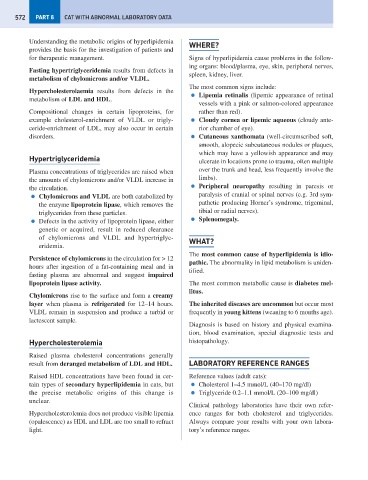Page 580 - Problem-Based Feline Medicine
P. 580
572 PART 8 CAT WITH ABNORMAL LABORATORY DATA
Understanding the metabolic origins of hyperlipidemia
WHERE?
provides the basis for the investigation of patients and
for therapeutic management. Signs of hyperlipidemia cause problems in the follow-
ing organs: blood/plasma, eye, skin, peripheral nerves,
Fasting hypertriglyceridemia results from defects in
spleen, kidney, liver.
metabolism of chylomicrons and/or VLDL.
The most common signs include:
Hypercholesterolaemia results from defects in the
● Lipemia retinalis (lipemic appearance of retinal
metabolism of LDL and HDL.
vessels with a pink or salmon-colored appearance
Compositional changes in certain lipoproteins, for rather than red).
example cholesterol-enrichment of VLDL or trigly- ● Cloudy cornea or lipemic aqueous (cloudy ante-
ceride-enrichment of LDL, may also occur in certain rior chamber of eye).
disorders. ● Cutaneous xanthomata (well-circumscribed soft,
smooth, alopecic subcutaneous nodules or plaques,
which may have a yellowish appearance and may
Hypertriglyceridemia ulcerate in locations prone to trauma, often multiple
Plasma concentrations of triglycerides are raised when over the trunk and head, less frequently involve the
the amounts of chylomicrons and/or VLDL increase in limbs).
the circulation. ● Peripheral neuropathy resulting in paresis or
● Chylomicrons and VLDL are both catabolized by paralysis of cranial or spinal nerves (e.g. 3rd sym-
the enzyme lipoprotein lipase, which removes the pathetic producing Horner’s syndrome, trigeminal,
triglycerides from these particles. tibial or radial nerves).
● Defects in the activity of lipoprotein lipase, either ● Splenomegaly.
genetic or acquired, result in reduced clearance
of chylomicrons and VLDL and hypertriglyc-
WHAT?
eridemia.
The most common cause of hyperlipidemia is idio-
Persistence of chylomicrons in the circulation for > 12
pathic. The abnormality in lipid metabolism is uniden-
hours after ingestion of a fat-containing meal and in
tified.
fasting plasma are abnormal and suggest impaired
lipoprotein lipase activity. The most common metabolic cause is diabetes mel-
litus.
Chylomicrons rise to the surface and form a creamy
layer when plasma is refrigerated for 12–14 hours. The inherited diseases are uncommon but occur most
VLDL remain in suspension and produce a turbid or frequently in young kittens (weaning to 6 months age).
lactescent sample.
Diagnosis is based on history and physical examina-
tion, blood examination, special diagnostic tests and
Hypercholesterolemia histopathology.
Raised plasma cholesterol concentrations generally
result from deranged metabolism of LDL and HDL. LABORATORY REFERENCE RANGES
Raised HDL concentrations have been found in cer- Reference values (adult cats):
tain types of secondary hyperlipidemia in cats, but ● Cholesterol 1–4.5 mmol/L (40–170 mg/dl)
the precise metabolic origins of this change is ● Triglyceride 0.2–1.1 mmol/L (20–100 mg/dl)
unclear.
Clinical pathology laboratories have their own refer-
Hypercholesterolemia does not produce visible lipemia ence ranges for both cholesterol and triglycerides.
(opalescence) as HDL and LDL are too small to refract Always compare your results with your own labora-
light. tory’s reference ranges.

